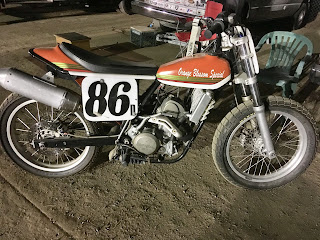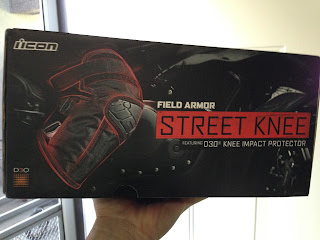Made it to the races while doing some race prepping!
Hey friends, I have been throwing myself into this Flat Track Racing thing full steam as much as I can. This post is proof of that. Ever since buying the new CRF450R Flat Tracker my mind has been Obsessed (of course) with getting out to the track. Last week I got out and was able to get 40 or 50 laps in. This week I was able to get back to the track for more than double that amount. I worked on the bike a bit and got out to some local races. This was all squeezed into normal life with a wife, a career and two kids. Sometimes the only thing I can do is watch YouTube for a little inspiration and technique tips. No one said getting out to be a never-was-been racer was going to be easy. Let's get to it!
Last Saturday was Round 1 of the Southern California Flat Track Association (SCFTA) season at Perris Raceway. I met up with some people at the track and checked out the class structure and race organization before I make my own racing debut. The track is a 1/8th mile short track and is the better of the two tracks available for the grassroots, club level, Flat Track racing we have here. I actually went to the wrong track. Perris Auto Speedway is about 20 minutes farther away and the place I initially ended up. I guess the fact that the 2017 American Flat Track season finale was at the Auto Speedway 1/2 mile track confused me. After pulling into a completely empty parking lot and quickly realizing my mistake, I hightailed it to the right track just in time for the opening ceremonies. I won't be doing that again!
I'll get back to the racing action in a bit. During the week I received my manual for the new bike. I ripped open the package an headed straight to the garage. It was bit cold since I was in my pajamas. I immediately read through the suspension adjustment section, grabbed a screwdriver and a socket and proceeded to see what the suspension settings were set at. I wrote them down and felt so much better about the bike by just having some data. I really am and engineering nerd (engi-nerd), but knowing where I am will help me to adjust how the bike feels with some seat time. I also read through a few other sections namely info about the fluids and maintenance intervals so that I could begin to make up my own maintenance plan and pre-track check lists. These may seem boring and a bit pedestrian, but it will be what keeps me racing when others are wrenching.
Another bit of prep work I did was to start making the bike my own. Having the race numbers on the bike is cool looking and makes me feel like I have (or at least the bike has) some street cred. The problem is that I need to make the bike my own. It is part of the man-machine bonding process. The easiest way to start is to remove the old graphics kit and clean up the bike for my own Motorbike Obsessions Race Team graphics that I will be designing in the future. I broke out the heat gun and in a few quick minutes I was peeling away the old graphics. It was just like removing a big sticker. They came off easily and any remaining glue residue was removed with some Goo Gone. I cleaned up the left and right side number plates as well as the rear fender and the front number plate.Now back to the racing. Here is a view down pit lane on the way to the stands, just after I walked into the track. The biggest thing that stood out was that 90% of the space and people in attendance were part of a racing outfit of some type. This is different from the races in Ventura where there were equal if not more people that came to watch as were in there paddock. This is real grassroots racing. This type of scene has been replicated all throughout the country since the early 19 teens back when America had over 100 motorcycle manufacturers. It was a real family atmosphere. Most of the groups had supporters and children running around. Many of the kids were racers themselves. The SCFTA has a class for just about any rider and bike. The accessibility to the racing struck me even more than it had at other races and track days I've attended. I was disappointed that I din't bring my own gear and bike with me.
There were bikes of all shapes, sizes and displacements. One of the first ones I saw was this beautiful Yamaha. I believe it is a TT500. They had a whole class for these bikes since they are very popular in the local Flat Track scene, especially with some of the more mature riders. When I arrived, the track staff was finishing the prep work for the races after closing down the practice sessions. I was able to walk through the pits and see all of the bikes and teams. I love being able to see how other people set up their pit area, how they transport their bike etc. so I can gather more ideas. One of the things that struck me was the groups of people pitted together. It looked liked clumps of families hanging out camping and grilling with motorcycles. I felt a little out of place since I think I was the only person at the race that was flying solo.
Another clean TT500 in another bare bones race set up. Just one guy, his truck and his bike at the races. These TT500's are single cylinder, 2 valve 500cc, 4 stroke dirt bikes from the 70's and 80's. The big thumpers make good Flat Track race bikes since they have excellent engine braking that help you to get pitched into the corners while you feather the rear brake to control your slide angle and modulate the throttle for traction. They sound awesome out on the track and just look so tough. I love the purposeful look of Flat Track race bikes. They are distilled to the essential elements of going fast. The big 19" wheels and thick tires look brutish. For the small tracks we ride you need simplicity
and purposefulness and Flat Track bikes deliver on both those aspects. the sport is simple. Go fast. Turn left. While there is less to remember, there is so much to perfect to get it right. You are always right on the edge of traction. So much happens in the 20 seconds it take to get around the track.
The races started and I spent a good 90 minutes just mesmerized by the racing. Everything from 5 year olds that couldn't even hold the bike upright to pro-level riders turning laps. After a short break in action, I toured through the pits again and saw this race bike. It is a Honda dirt bike single cylinder engine in a custom built Flat Track frame. These bike are called framers and back in the day before the introduction of the DTX classes were the way to go fast. The expense of running a framer is what lead to the need for lower cost Flat Trackers so that the sport would continue at the local level. The DTX bikes were so successful that the pro level AMA races have a class just for these bikes. I love the fact that my simple CRF450R engine could be used in a lighter, more race oriented frame. One day I may build something like this just for the fun of it.
Here is the track. Perris Raceway co-located with a Motocross Park of the same name. This is a 1/8th mile groove type track with a pretty wide riding line that allows for some tight racing within its small confines. I am learning the types of tracks that Flat Track racers refer to. A groove track is harder packed dirt with very little give. It gets its name from the fact that the race bikes leave a thin strip of soft tire rubber in the dirt which forms a blue groove that is very high in traction. If you get "Off the Groove" you risk losing all drive from traction loss. Sometime the groove is as wide as one bike's tire width. Other times it is big enough to get a few bikes banging bars through the turns. The other type of track is called a cushion track. This are more common back east in areas of more rain. The dirt is softer and more like a MX track, but not quite as deep. They offer great traction, but just like MX tracks they can form ruts and bumps that add challenges to getting clean laps. The groove tracks can be fast until they get dry where they become like concrete covered in marbles. There are other tracks that have special surfaces like the Lima Half Mile in Ohio that has a pea gravel track notorious for sand blasting those riders not fast enough to be up front.Since I'm no pro-photographer, these are the best shots I could get of the race action. The one on the left is from the start and the right pic is a couple of laps in. Like I mentioned, the track is tiny at around 1/8th of a mile. Lap times are quick. From my own practice sessions I can tell you that things come quick. It is the same technique for every set of corners and you have to do it twice per lap. There is very little time between corners to get ready for the next set of turns. The heat races are 6 lap races and the mains races are 8 laps, I think. Every time I tried to count I'd forget the number because I was concentrating on the action. The fast class races are about 2 minutes each. The SCFTA races have a class for every age group and type of bike. They would combine some classes if the class was small in order to get enough people to make it a race. There were 29 heat races and 25 mains races. In between the heats and mains they did a full track prep. It was a smoothly organized and well run show. I can't wait until I get enough seat time to give it a go.
As I type this I'm sore and tired from getting out this week to practice. I'll save the write up for the next post. Lets just say that the Flat Track community is small and awesome. I learned so much this week that I should be racing really soon if I can get more of the same good practice in. Stay tuned for more action from the dirt. Ride safe friends!
Blue















Comments
Post a Comment
Thanks for your comments and for following My Motorbike Obsessions!